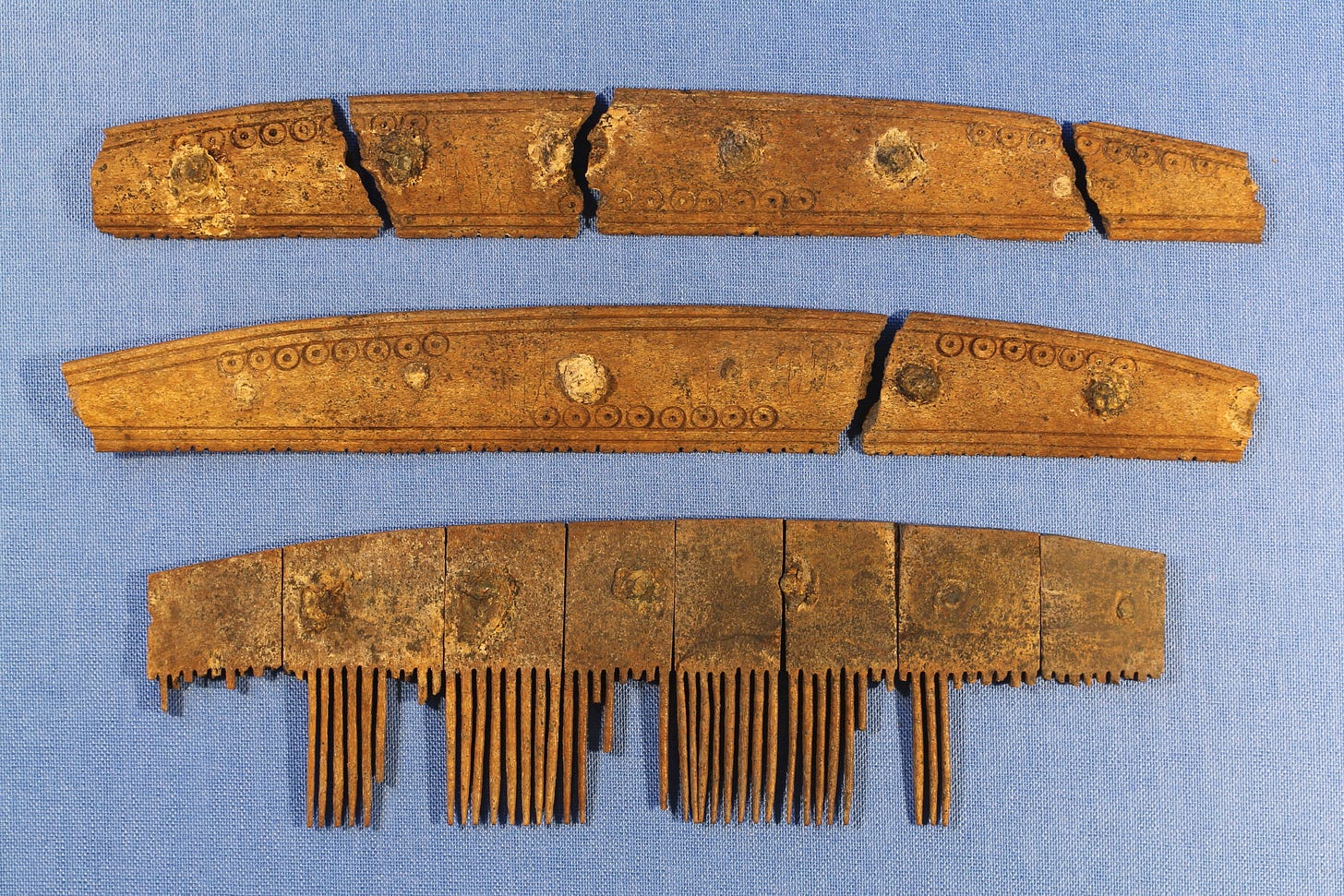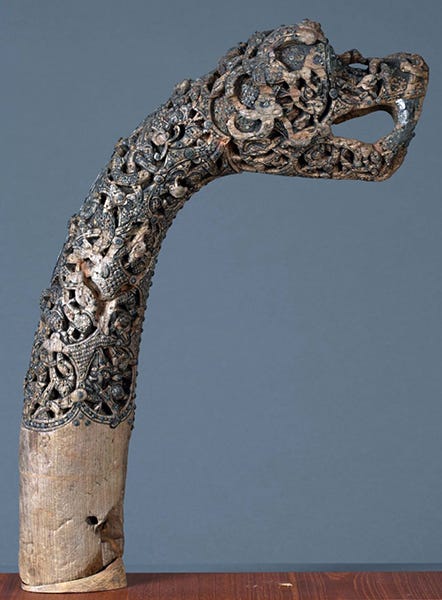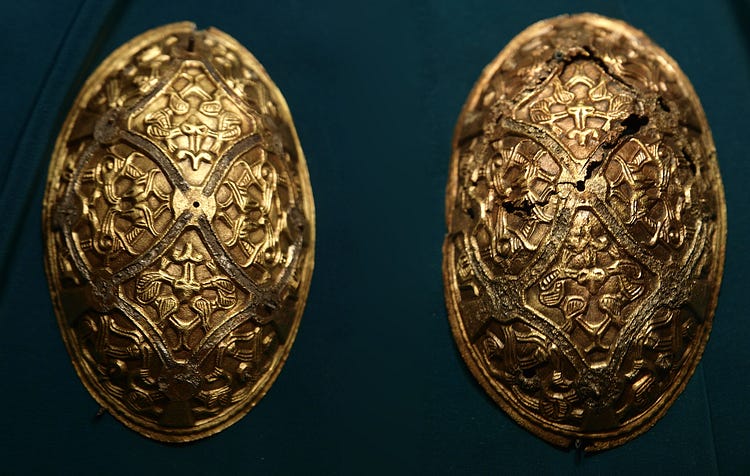Viking: a user's guide to getting it wrong
Historians, nationalists, and Netflix all helped invent a Viking identity that never really existed
No one woke up in the middle of the 8th century screaming “We are Vikings!”. While the term is still used in scholarship to denote late Iron Age Scandinavians and not only the occupation of going abroad to raid, trade and explore, we should refute the simplistic notion that Vikings constituted a single, monolithic ethnicity. The reality is far more interesting, reflecting a vibrant mosaic of regional identities and cultural variations across the vast Scandinavian landscape.
One people
Linguistically, we can notice that distinct dialects like Old West Norse and Old East Norse already started to emerge in the 9th century. These linguistic divergences, evidenced in laconic runic inscriptions and later vernacular manuscripts, challenge the idea of a unified Viking language and underscore the regional identities that shaped Viking culture. Medieval sources, often penned by those who bore the brunt of Viking raids, employed sweeping terms like "Northmen," "Danes," or "heathens," neglecting to differentiate between the specific groups involved. This tendency to homogenize Vikings as a single, undifferentiated entity fuelled the misconception of their unified nationhood. The term "Danish Tongue" to designate Old Norse does not suggest a singular cultural identity.
The 19th-century Romantic nationalism movement, while igniting interest in Viking heritage, romanticized their image as a unified force embodying a shared Scandinavian identity. This idealized portrayal often obscured the complex realities of inter-group conflicts, power struggles, and the fluid nature of alliances that characterized Viking society. For example, the Geatish Society, founded in 1811, focused on a generalized, romanticized northern world and promoted a unified, albeit inaccurate, view of Viking culture. The Scandinavian medieval nations were in their nascent stages during the Viking Age. Allegiances were primarily to local communities, chieftains, and regional powers rather than a broader, cohesive national identity.
We often impose a rigid dichotomy between "Danes" and "Norwegians," a distinction that may not have existed in the 9th and 10th centuries. If we examine various terms used in primary sources, we’re going to notice their ambiguity and the challenges of assigning fixed ethnic identities to Viking groups. Have a look, for example, at "Finngaill" and "Dubgaill" ("Fair Foreigners" and "Dark Foreigners"). These terms, found in Irish chronicles, have been traditionally interpreted as distinct ethnic groups, with "Finngaill" associated with Norwegians and "Dubgaill" with Danes. However, Clare Downham, who wrote quite a bit on the topic, drawing on the work of David Dumville, argues that this interpretation is flawed. She suggests that "dark" denoted newer or later groups while "fair" referred to earlier ones. Downham proposes that "Dark Foreigners" might specifically identify those under the leadership of the family of Ívarr, highlighting the fluidity of these designations.
Then we have "Danus" and "Normannus" in Latin sources. These terms, often translated as "Dane" and "Norwegian," frequently appear as general appellations for Scandinavians rather than specific ethnic identifiers. In the Frankish Latin sources, the usage of these terms seems to reflect authorial preference rather than distinct ethnic groups. Likewise, "Dene" and "Norðmann" in English sources in The Anglo-Saxon Chronicle prove to be equally ambiguous. The chronicle often employs these terms interchangeably when describing the same individuals or groups, challenging the notion of clear ethnic distinctions. For instance, in the year 787, "Norðmenn" are identified as "Denisc," blurring the lines between these supposedly separate groups.
Hence, perhaps the most useful thing we can do is to try and employ the term "Viking" as a deliberately vague umbrella term to encompass individuals of Scandinavian culture who were active outside Scandinavia. This approach would avoid imposing modern national categories onto a period where cultural interactions and fluid allegiances were the norm. Vikings did not constitute a homogenous nation but rather hailed from diverse regions across Scandinavia with distinct customs and even political rivalries. New archaeological insight combined with very modern methods like DNA and isotope analysis have revealed the mixed composition of Viking armies, which often included individuals from various Scandinavian regions and even incorporated indigenous peoples, further complicating attempts to categorize them based on strict ethnic lines. The Irish chronicles themselves show difficulties in the initial use of the broad term "foreigners" (Gaill, echtrainn, allmuire) to describe Viking settlers, a designation lacking specific ethnic connotations.

By questioning the terminology used to designate Vikings, we can challenge conventional narratives and emphasize the fluidity and complexity of identity in the Viking Age. These are not just sociological buzz words, but encourage a more nuanced understanding of this historical period, recognising that modern concepts of ethnicity and nationality cannot be easily mapped onto the past. In essence, Vikings were not a monolith, but a tapestry of diverse groups, bound together by certain common cultural threads yet distinguished by unique regional identities, motivations, and ambitions.
Part-time gig?
Alright, we can shout out that Viking was a profession then. Well, sort of. I think the term social identity would best fit the picture, a way of life rather than an inherent characteristic of all Scandinavians. Our sources paint a picture of a diverse Viking Age Scandinavian society, where the majority were not engaged in the activities commonly associated with Vikings. Farmers, fishermen, craftspeople, merchants, and various other professions constituted the backbone of the social structure, their lives revolving around subsistence, local trade, and community life. Nevertheless, some of these could intertwine if you went abroad vikinging”. We can see it particularly in the case of the Norse travelling East, managing to infiltrate the vast trading networks on the Volga, Dniepr and further into Byzantium and the Abbasid Empire. You could alternate between raiding and trading, depending on which seemed more lucrative at the time.
Then there is the very important aspect of elite patronage and social mobility. While a relatively small segment of the population actively participated in Viking expeditions, their ventures were often sponsored and supported by the elite class, comprising chieftains and wealthy landowners who sought to expand their power, wealth, and influence. These expeditions offered opportunities for young men seeking upward social mobility, wealth accumulation, or a life of adventure. We are still dwelling on older Victorian obsessions with the romanticized notion that all Scandinavians yearned for a life of raiding, plunder, and exploration. For many, though, the practicality and stability of life as farmers, merchants, or skilled artisans held greater appeal than the uncertainties and risks associated with the Viking vocation. Pragmatism would have been a much larger driving force; in the end, it is a universal human constant.
The distinction between the Viking profession, pursued by a select few, and the broader Scandinavian society, encompassing a wide array of livelihoods and aspirations, is crucial to avoid the misconception that all Scandinavians were Vikings.
Barbarian rage
Alas, another maddening stereotype casts the Vikings as uncultured hordes in a Conan the Barbarian type of setting. This enduring misconception, stemming from biased narratives and the influence of certain historical interpretations, can also be deconstructed. Unfortunately, the Norse didn’t really write about themselves, rather their descendants did, and here we move into the realm of memory studies (what you remember about the past and why). During the Viking age, Christian chroniclers, understandably traumatized by Viking raids, often highlighted the desecration of monasteries, the plunder of churches, and the violence inflicted upon Christian communities. These accounts, invaluable as historical sources, often presented a one-sided portrayal of Vikings, emphasising their brutality and ruthlessness as invaders, thereby contributing to the barbarian stereotype. For example, Alcuin of York's letter (c. 793) vividly describes the devastation and terror inflicted by Viking raids on the church of St. Cuthbert, reinforcing the image of Vikings as merciless and godless barbarians. Similarly, the anonymous author of Cogadh Gaedhel re Gallaibh (The War Between the Irish and the Foreigners), written around 1114-1116, emphasizes the immense suffering endured by the Irish people at the hands of the Vikings, painting a stark picture of their barbarity and pagan ruthlessness.
Fast forward several centuries, and the "noble savage" trope arises. The Romantic movement, while captivated by Viking culture and literature, also played a role in perpetuating loads of stereotypes. Vikings were frequently depicted as untamed, primaeval figures possessing an innate strength and vitality that contrasted with the perceived decadence and over-civilization of contemporary European society. This interpretation, while acknowledging certain aspects of Viking culture, often reinforced the notion of Vikings as being outside the realm of civilized society. It’s quite similar to how Tacitus used the Germanic tribes to make critical political statements about the Roman world.
These ”barbarians”, however, showed no lack of technological advancements and artistic prowess: the remarkable technological sophistication of Vikings, particularly in shipbuilding, navigation, and craftsmanship clearly counter such a stereotype. Their ability to construct remarkably durable and seaworthy ships, especially using the clinker technique, navigate vast distances using geographic cues, manipulate coloured glass to create beads, or engineer durable and ornate objects like combs from animal bone, challenges the perception of Vikings as technologically primitive. The Gokstad and Oseberg ships, both meticulously crafted vessels discovered in Norway, stand as testaments to Viking shipbuilding and artistic prowess. The Oseberg ship, in particular, with its ornate carvings and intricate design, reveals a level of craftsmanship that defies the barbarian stereotype. Modern media, spanning films, television shows, video games, and popular literature, often perpetuate the barbarian clichés, portraying Vikings as bloodthirsty hordes driven by an insatiable thirst for conquest and plunder. Because we like stories of violence and horror, who’d want to watch a rune carver painstakingly toil away on a memorial stone? Or a weaver stuck for days in a pit house working on a new sail? While these representations can be very entertaining, they frequently lack nuance and historical realism, overlooking the complexities of Viking motivations and their significant contributions to trade, exploration, and cultural exchange.
Oversimplification is killing the Viking Age. We need to advocate for a more nuanced and multifaceted understanding of the Norse in public history as well: that means acknowledging the undeniable brutality of their raids but also recognizing their technological innovations, artistic capabilities, sophisticated social structures, and the exchange facilitated through interactions with other societies.







Thanks for this. I was told by an old fisherman on Skye that "viking was a verb, not a noun." He also said some of the raids on Skye included men that looked "like Turks."
Great article which fills an immense gap in my knowlege. Thanks.